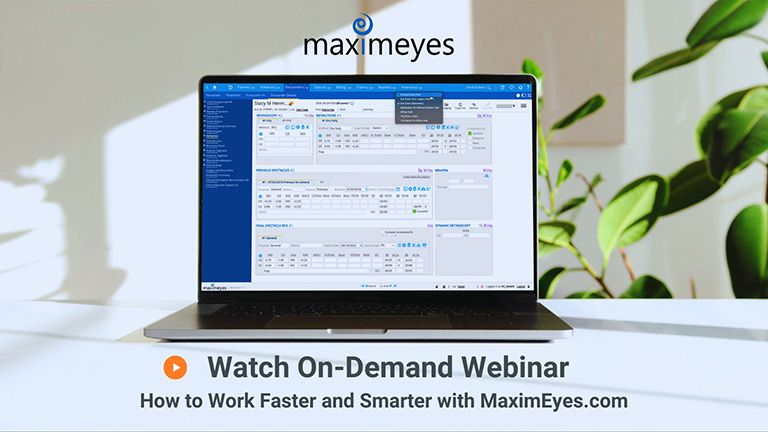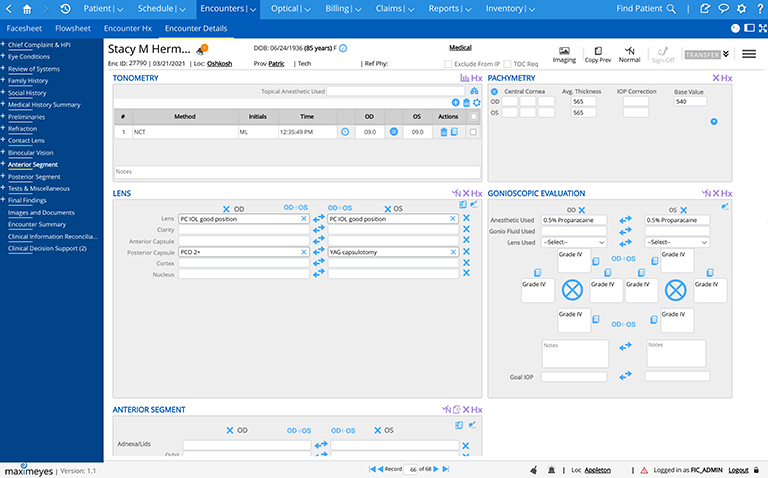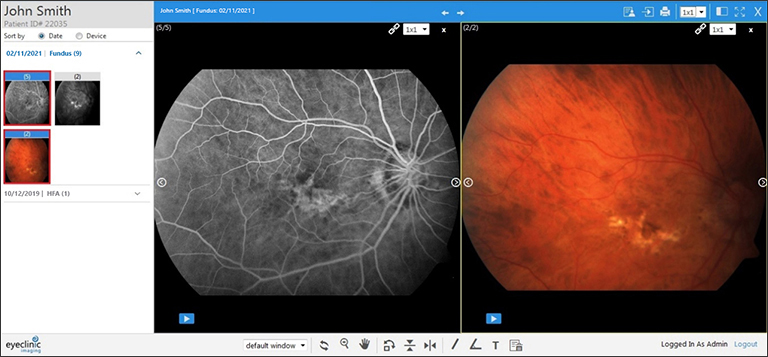
01 Dec How Optometry EHR Optimization Improves Patient Flow
Not using optometry EHR and practice management software technology to the fullest is a common pain point for eye care professionals. Choosing a highly customizable EHR is crucial to solving operational challenges, simplifying patient flow management, and reaching business goals.
Picture optimizing your EHR as fine-tuning implementation processes to improve clinical productivity and office efficiencies. It’s a method of tailoring and improving how the system works the way you do and adjusting what slows you down.
Let’s review critical areas that impact efficient EHR optimization and how this affects your documentation and patient flow.
Simple EHR Software User Interface Design Matters
An optometry EHR user interface (UI) or system design dramatically affects the user experience, workflows, clinical decision-making, and compliance. A clean, modern, and intuitive interface design simplifies navigation and accelerates the learning curve.
When First Insight designed MaximEyes.com, we spent considerable time with eye care professionals testing and validating the system design, walking through different workflows, and ensuring the layouts match what practices need.
Efficiently managing patient flow impacts staff performance, patient experiences, and revenue growth. With MaximEyes.com, you’ll spend more time communicating with your patients and less time clicking buttons and entering data.
The best eye care EHRs allow you to see more data per screen without overwhelming the user. Many EHR systems require users to click through multiple screens or pop-ups. MaximEyes.com minimizes these annoyances—the result is faster navigation.
Customizing Optometry EHR Workflows Removes Clutter
A good optometry EHR allows you to customize workflows, so you have control and can use it your way. Because every practice and doctor is unique, it’s critical to have a comprehensive EHR that only displays test elements or data entries you need for that encounter.
Your EHR should allow you to remove clutter on the screen—a less is more approach. For instance, in the MaximEyes.com unified EHR and practice management system, you can:
- Create customized forms and templates to fit workflows for different types of encounters.
- Use a one-page form to organize data elements on multiple screens.
- Arrange data elements anywhere on any screen, like puzzle pieces, to exclude or include a test as appropriate.
- Select from a library of elements to create and modify data elements.
- Duplicate data elements on multiple screens to prevent the doctor or technician from jumping back and forth in the exam to see previously entered data.
- Switch forms midstream during the exam and carry forward any data already entered into the new template.
Why Simplified Data Entry Methods Matter for Eye Care EHR
Code Complete Rules Engine
Code Complete in MaximEyes.com is an embedded tool that you can modify. Based on your exam findings, it will suggest or trigger diagnosis or procedure codes, outbound documents, and alerts.
Eliminate the need to remember findings or look back at the exam form to view them to code correctly. Not only does this speed up finalizing the encounter, but it also helps ensure you bill accurately and get paid for the procedure you performed.
Customizable Value Lists
When designing your data elements in MaximEyes.com, use a drop-down value list, a free text field, or a combo field. The combo field allows you to easily filter the list to choose one or multiple values. Free text type almost anywhere vs. limiting it to a notes box, edit lists on the fly, and order lists by most commonly used or alphabetically.
Eliminate Redundant Data Entry
While redundant data entry is standard in most eye care EHRs, MaximEyes.com gives you the ability to customize pre-populated data such as preferred normals and initial data. Whether it’s baseline data for new patients or pulling history from past exams, all can be customized so you only pull in the relevant information for the encounter.
Preset Procedure Code Bundles
If you prefer preset codes in a particular exam type you are doing, one click selects multiple codes for commonly used code groupings. Code bundles in MaximEyes.com eliminate the need to type, search, and click multiple times for each code. Pick and choose data points you want to see on one screen for multiple visits over time. Create flow sheets for different data groupings, such as glaucoma and diabetes.
“Being able to customize our optometry exam templates to fit how we use the system most of the time is a critical reason why we love MaximEyes.com. It is also helpful that previous exam findings copy forward to the new patient record without re-entering data.” –Chet Myers, OD (read his success story)
Ophthalmic Image Management Enhances Patient Diagnosis and Decision-Making
Ophthalmic testing data is highly complex. Using multiple software programs to view patient ophthalmic images from diagnostic equipment will slow you down if test results don’t integrate with your eye care EHR.
You can move away from storing and archiving images locally by migrating your data to a cloud-based ophthalmic image management system such as EyeClinic Imaging. You no longer need to worry about backup images from medical equipment since images are backed up to the cloud at the time of creation by the instruments.
Using MaximEyes.com with EyeClinic.net shows different data sets, such as OCT scans and visual field testing that you can view simultaneously. You can enlarge the scans so patients can easily view the results on the computer screen while they are in the exam chair.
“The images and testing results automatically upload into EyeClinic Imaging, where I can review them with a single click directly from within MaximEyes.com EHR. I can view images side-by-side to detect and annotate any changes. And EyeClinic Imaging helps me educate patients on why they need these tests.” –Peter Falk, OD (read his success story)
Two-Way E-Prescribing and Medication Adherence Tools Improve Patient Health Outcomes
Electronic prescribing (e-prescribing) and medication adherence tools built-in to optometry EHR systems give doctors quick access to medication history data and advanced clinical, behavioral, and financial support tools. These e-prescribing tools help drive higher levels of medication adherence and improve patient health outcomes.
Many states have passed or have introduced electronic prescribing mandates for controlled substances (EPCS). In addition, these states are taking it one step further by requiring healthcare providers to prescribe both controlled and non-controlled substances electronically.
To give you an idea, beginning January 1, 2022, all California (Learn More) and Michigan (Learn More) healthcare providers who have the authority to prescribe medications must issue electronic prescriptions for both controlled and non-controlled substances.
When searching for eye care software, verify that your EHR offers integrated two-way electronic prescribing and medication adherence solutions. A bi-directional e-prescribing integration allows providers to send prescriptions and import a list of medications prescribed by other physicians.
Boost Office Efficiencies Using Intuitive Optometry Software
The right optometry EHR and practice management software will take your eye care practice to the next level by helping you serve your patients better and faster. MaximEyes.com has all the features you can expect to find in a top-of-the-line unified system. Your relationship with us is just the beginning. We’ll get you up and running quickly without compromising patient care.







